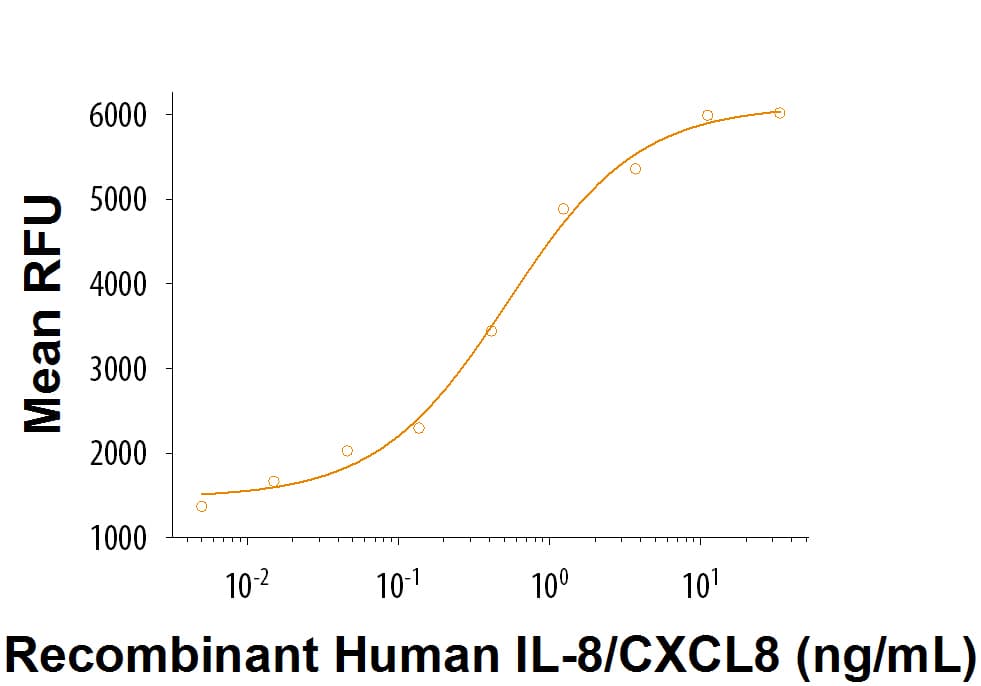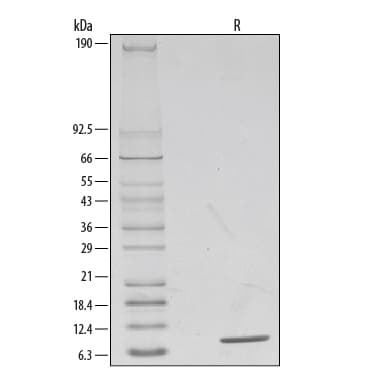 全部商品分类
全部商品分类



 下载产品说明书
下载产品说明书 下载SDS
下载SDS 用小程序,查商品更便捷
用小程序,查商品更便捷


 收藏
收藏
 对比
对比 咨询
咨询Scientific Data
 View Larger
View LargerRecombinant Human IL-8/CXCL8 (Catalog # 208-IL) chemoattracts the BaF3 mouse pro-B cell line transfected with human CXCR2. The ED50 for this effect is 0.5-2.5 ng/mL.
 View Larger
View Larger1 μg/lane of Recombinant Human IL-8/CXCL8 was resolved with SDS-PAGE under reducing (R) conditions and visualized by silver staining, showing a single band at 8 kDa.
Carrier Free
CF stands for Carrier Free (CF). We typically add Bovine Serum Albumin (BSA) as a carrier protein to our recombinant proteins. Adding a carrier protein enhances protein stability, increases shelf-life, and allows the recombinant protein to be stored at a more dilute concentration. The carrier free version does not contain BSA.
In general, we advise purchasing the recombinant protein with BSA for use in cell or tissue culture, or as an ELISA standard. In contrast, the carrier free protein is recommended for applications, in which the presence of BSA could interfere.
208-IL
| Formulation | Lyophilized from a 0.2 μm filtered solution in PBS with BSA as a carrier protein. |
| Reconstitution | Reconstitute at 100 μg/mL in sterile PBS containing at least 0.1% human or bovine serum albumin. |
| Shipping | The product is shipped at ambient temperature. Upon receipt, store it immediately at the temperature recommended below. |
| Stability & Storage: | Use a manual defrost freezer and avoid repeated freeze-thaw cycles.
|
208-IL/CF
| Formulation | Lyophilized from a 0.2 μm filtered solution in PBS. |
| Reconstitution | Reconstitute at 100 μg/mL in sterile PBS. |
| Shipping | The product is shipped at ambient temperature. Upon receipt, store it immediately at the temperature recommended below. |
| Stability & Storage: | Use a manual defrost freezer and avoid repeated freeze-thaw cycles.
|
Recombinant Human IL-8/CXCL8 Protein Summary
Product Specifications
Ser28-Ser99
Analysis

Background: IL-8/CXCL8
Interleukin-8 (IL-8), also known as CXCL8, GCP-1, and NAP-1, is a widely expressed proinflammatory member of the CXC family of chemokines. Near its N-terminus, this 8-9 kDa chemokine contains an ELR motif which is important for its angiogenic properties (1). IL-8/CXCL8 can associate into a homodimer or a heterodimer with CXCL4/PF4 (2), and it can also interact with matrix and cell surface glycosaminoglycans (3). Mature human IL-8/CXCL8 shares 65%-69% amino acid (aa) sequence identiity with canine, feline, and porcine IL-8/CXCL8 (4). There is no IL-8/CXCL8 gene counterpart in rodent. N-terminal truncation by multiple proteases generates a range of shorter forms, and an alternative splice form of human IL-8/CXCL8 carries an eleven aa substitution at the C-terminus (5). The bioactivity of IL-8/CXCL8 is regulated by these truncations, by IL-8/CXCL8 citrullination at Arg5 (N-terminal to the ELR motif) (6), and by the decoy receptor DARC (7). IL-8/CXCL8 effects are mediated through CXCR1/IL-8 RA, which is also used by CXCL6, and through CXCR2/IL-8 RB, which is used by multiple CXC chemokines (1). CXCR1 and CXCR2 associate into functional homodimers and heterodimers with each other (8). Through both CXCR1 and CXCR2, CXCL8 promotes neutrophil adhesion to the vascular endothelium and migration to sites of inflammation (9). It triggers the antimicrobial activation of neutrophils through CXCR1 (10). CXCL8 also binds to Serpin A1/alpha-1 Antitrypsin, and this prevents IL-8/CXCL8 interaction with CXCR1 (11). IL-8/CXCL8 is upregulated in atherosclerotic lesions and other cardiac pathologies where it exacerbates inflammatory tissue damage (12). In addition, it induces VEGF expression, vascular endothelial cell proliferation, angiogenesis, and tumor cell invasiveness (13-16).
- Lazennec, G. and A. Richmond (2010) Trends Mol. Med. 16:133.
- Nesmelova, I.V. et al. (2005) J. Biol. Chem. 280:4948.
- Pichert, A. et al. (2012) Biomatter 2:142.
- Schmid, J. and C. Weissmann (1987) J. Immunol. 139:250.
- Mortier, A. et al. (2008) Pharmacol. Ther. 120:197.
- Proost, P. et al. (2008) J. Exp. Med. 205:2085.
- Neote, K. et al. (1994) Blood 84:44.
- Munoz, L.M. et al. (2009) J. Immunol. 183:7337.
- Gerszten, R.E. et al. (1999) Nature 398:718.
- Jones, S.A. et al. (1996) Proc. Natl. Acad. Sci. USA 93:6682.
- Bergin, D.A. et al. (2010) J. Clin. Invest. 120:4236.
- Apostolakis, S. et al. (2009) Cardiovasc. Res. 84:353.
- Martin, D. et al. (2009) J. Biol. Chem. 284:6038.
- Li, A. et al. (2005) Angiogenesis 8:63.
- Waugh, D.J. and C. Wilson (2008) Clin. Cancer Res. 14:6735.
- Fernando, R.I. et al. (2011) Cancer Res. 71:5296.


参考图片
1 μg/lane of Recombinant Human CXCL8/IL‑8 was resolved with SDS-PAGE under reducing (R) conditions and visualized by silver staining, showing a single band at 8 kDa.
Recombinant Human CXCL8/IL-8 (Catalog # 208-IL) chemoattracts the BaF3 mouse pro-B cell line transfected with human CXCR2. The ED50 for this effect is typically 0.5-2.5 ng/mL.



